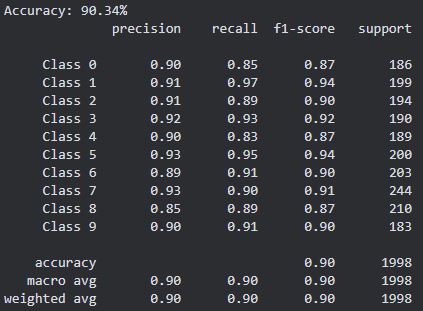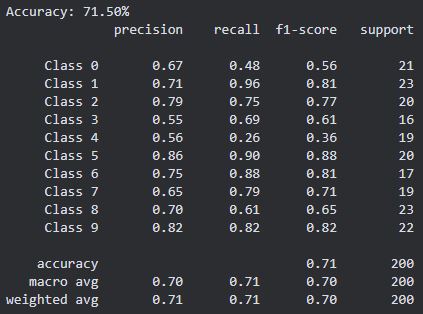CS 4641 Machine Learning, Team 6, Midterm Report
Members: Austin Barton, Karpagam Karthikeyan, Keyang Lu, Isabelle Murray, Aditya Radhakrishan
Introduction
Our project’s goal is to perform two different slightly different classification tasks on two different music audio datasets, MusicNet and GTZAN. For GTZAN, we are performing a genre classification task. For MusicNet, the task is to identify the composer for a given input of audio data from the baroque and classifcal periods of music. Both of these datasets are taken from Kaggle and work in classification has recently gotten up to ~92% [4.]. Previous works struggled getting any model above 80% [1.], [2.]. One study introduced a gradient boosted ensemble decision tree method called LightGBM that outperformed fully connected neural networks [2.]. Results these days outperform them but not much recent work has been done in using tree classifiers in this problem and most implementations appear to focus on neural network implementations. Therefore, we aim to re-examine decision trees’ abilities for this task and attempt to improve upon neural network results. Additionally, in our exploratory data analysis and data pre-processing we would like to consider non-linear, as well as linear, dimensionality reduction techniques. We would like to evaluate these different methods similar to Pal et al., [3], by reducing dimensions to a specified number, running a clustering algorithm on the data, and then evaluating results posthoc. In their results, t-SNE consistently outperformed other dimension reduction techniques. Therefore, we plan to use t-SNE in order to better understand and visualize our data in addition to principle components analysis (PCA). Currently, our work focuses on data pre-processing, visualization, using PCA for our dimensionality reduction technique, and obtaining base line results on minimally processed data with simple Feedforward Neural Network architectures.
Datasets
MusicNet: We took this data from Kaggle. MusicNet is an audio dataset consisting of 330 WAV and MIDI files corresponding to 10 mutually exclusive classes. Each of the 330 WAV and MIDI files (per file type) corresponding to 330 separate classical compositions belong to 10 different composers from the classical and baroque periods. The total size of the dataset is approximately 33 GB and has 992 files in total. 330 of those are WAV, 330 are MIDI, 1 NPZ file of MusicNet features stored in a NumPy array, and a CSV of metadata. For this portion of the project, we essentially ignore the NPZ file and explore our own processing and exploration of the WAV and MIDI data for a more thorough understanding of the data and the task.
GTZAN: GTZAN is a genre recognition dataset of 30 second audio wav files at 41000 HZ sample rate, labeled by their genre. The sample rate of an audio file represent the number of sample, or real numbers, that the file represent one second of audio clip by. This means, for a 30 second wav file, the dimensionality of the dataset is 41000x30. The data set consists of 1000 wav files and 10 genres, with each genre consisting of 100 wav files. The genres include disco, metal, reggae, blues, rock, classical, jazz, hiphop, country, and pop. We took this data from Kaggle.
Problem Definition
The problem that we want to solve is the classification of music data into specific categories (composers for MusicNet and genres for GTZAN). Essentially, the existing challenge is to improve previous accuracy benchmarks, especially with methods beyond neural networks, and to explore alternative models like decision trees. Our motivation for this project was to increase classification accuracy, improve the potential of decision trees in this domain, and to better understand and interpret the models that we chose to use. Our project aims to contribute to the field of music classification and expand the range of effective methodologies for similar tasks.
Despite the dominance of neural networks in recent works, there’s motivation to enhance their performance and explore if combining methods can gain better results. The references and readings suggest that decision trees, especially gradient-boosted ones, might perform comparably and offer advantages in terms of training time and interpretability. Based on this, the project aims to effectively reduce the dimensionality of the datasets, enhancing the understanding and visualization of the data using techniques like t-SNE and PCA.
Methods Overview
We utilize Principal Component Analysis as our dimensionality reduction technique for visualization as well as pre-processing data. We implement classification only on the GTZAN data and specifically utilized Feedforward Neural Networks/MLPs. Further discussion of these methods is explained in the Data Preprocessing and Classification sections.
Exploratory Data Analysis (EDA)
MusicNet: For MusicNet, we thoroughly explore visualization of both WAV and MIDI data files in various ways, using our own created methods, open-source programs, and a mix of the two.
MIDI File Visualization
We will first go through the MIDI file exploration for Beethoven’s 3rd Movement of the famous Moonlight Sonata composition. Something very important to be aware of is how many different MIDI file formats exist and how different some MIDI files may be in certain portions of their structure. The software we used to visualize and parse through MIDI files are open-source and can be found at python-midi and music21. In the following example, the MIDI file is broken down into a left hand and right hand portion of the piano solo played. Below is a sample of the right hand and left hand from measures 1 to 10 shown in separate plots, in their respective order.
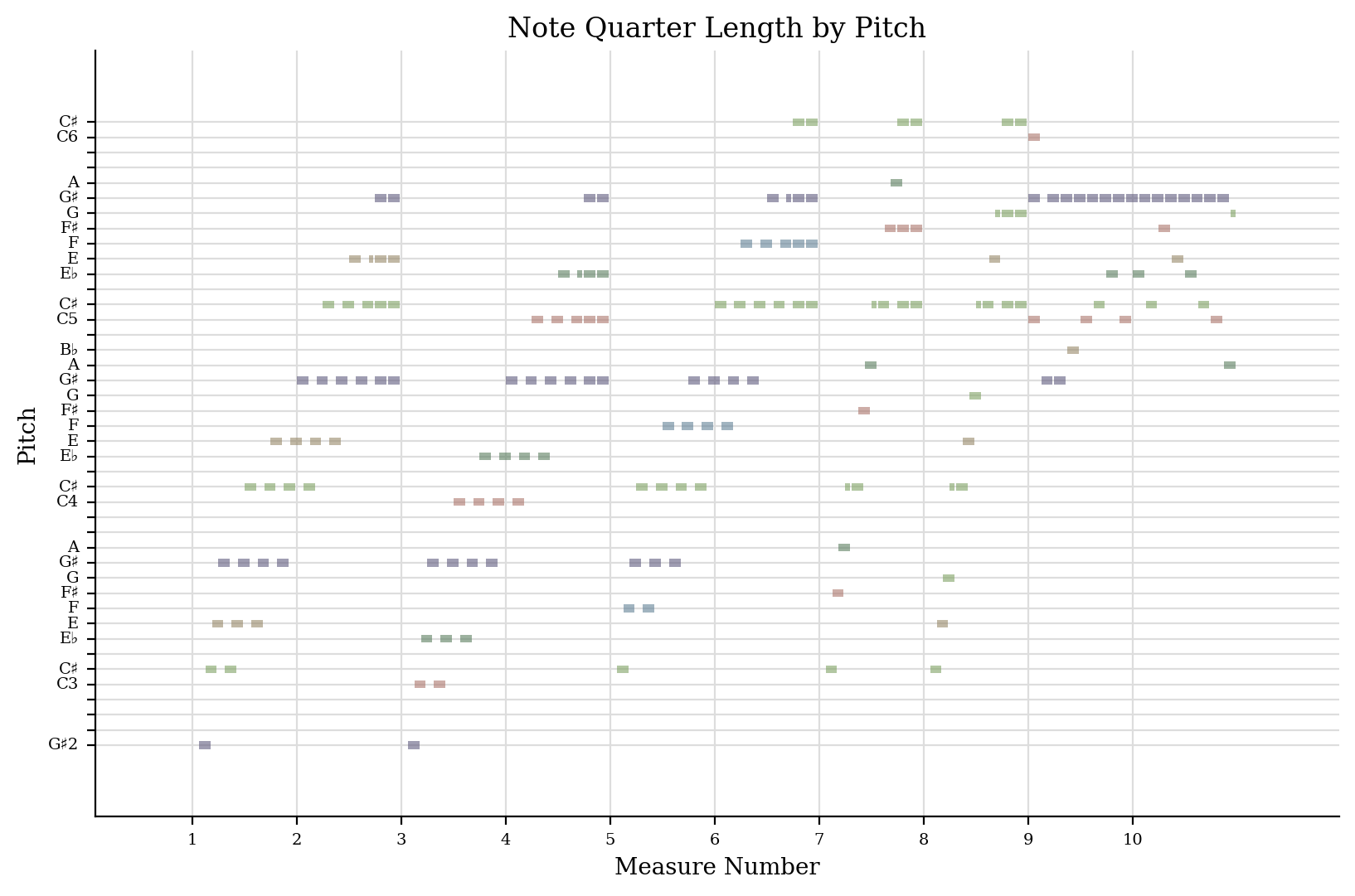
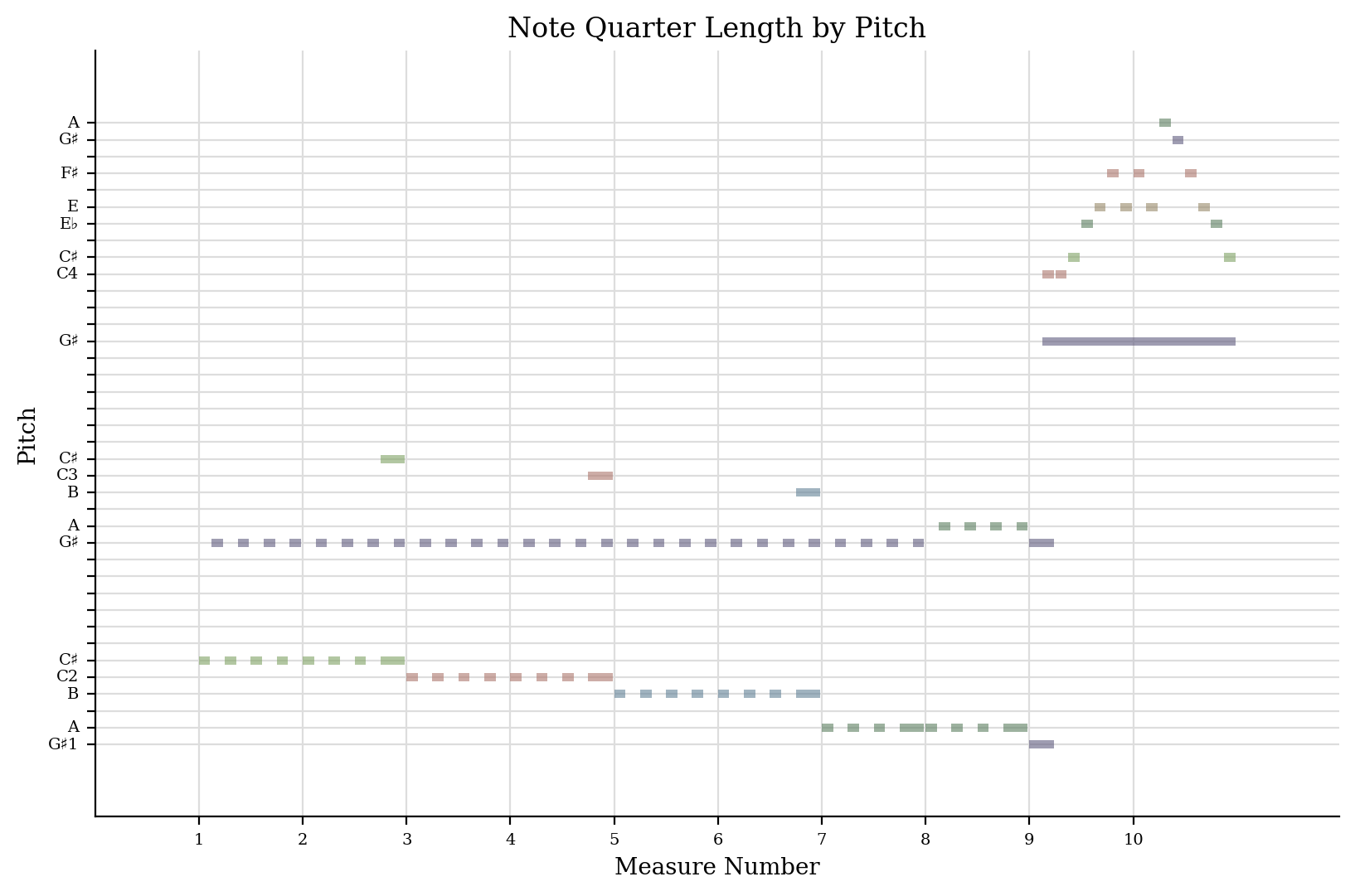
If you’ve ever listened to this song, you’ll immediately recognize the overall pattern of the notes. Below is a sample of the left and right-hand notes from measures 1 to 6.
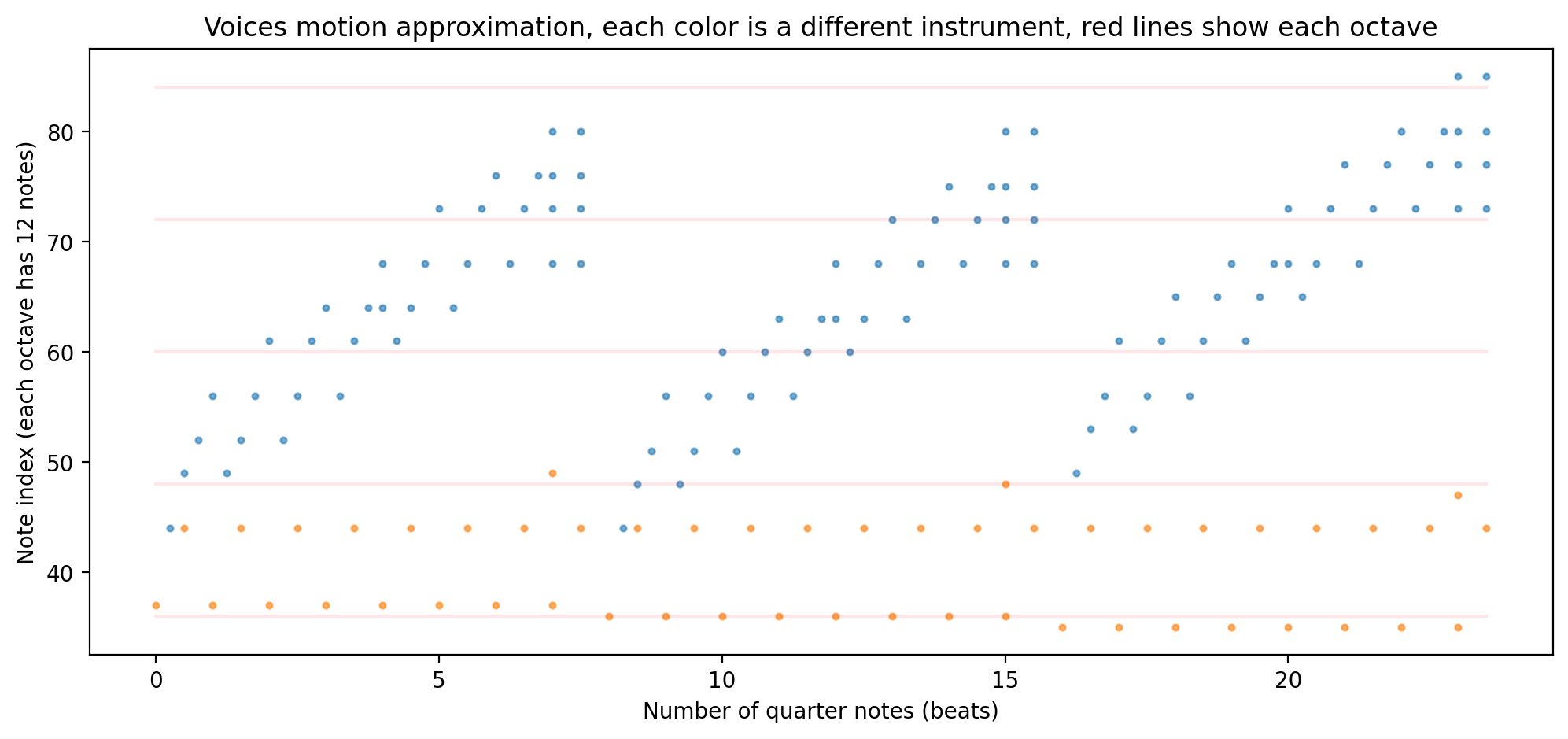
Below we show the frequencies of certain pitches and quarter-length notes at certain pitches.
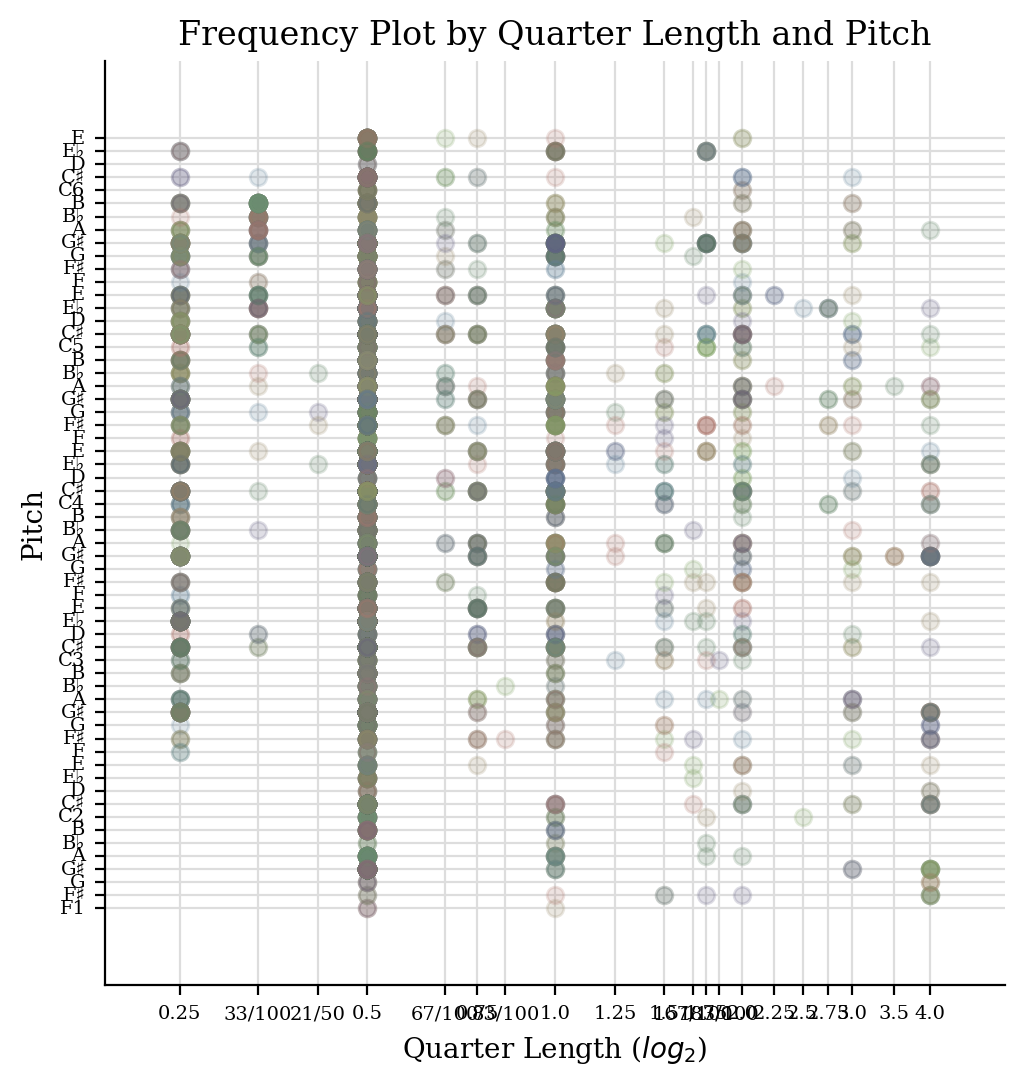
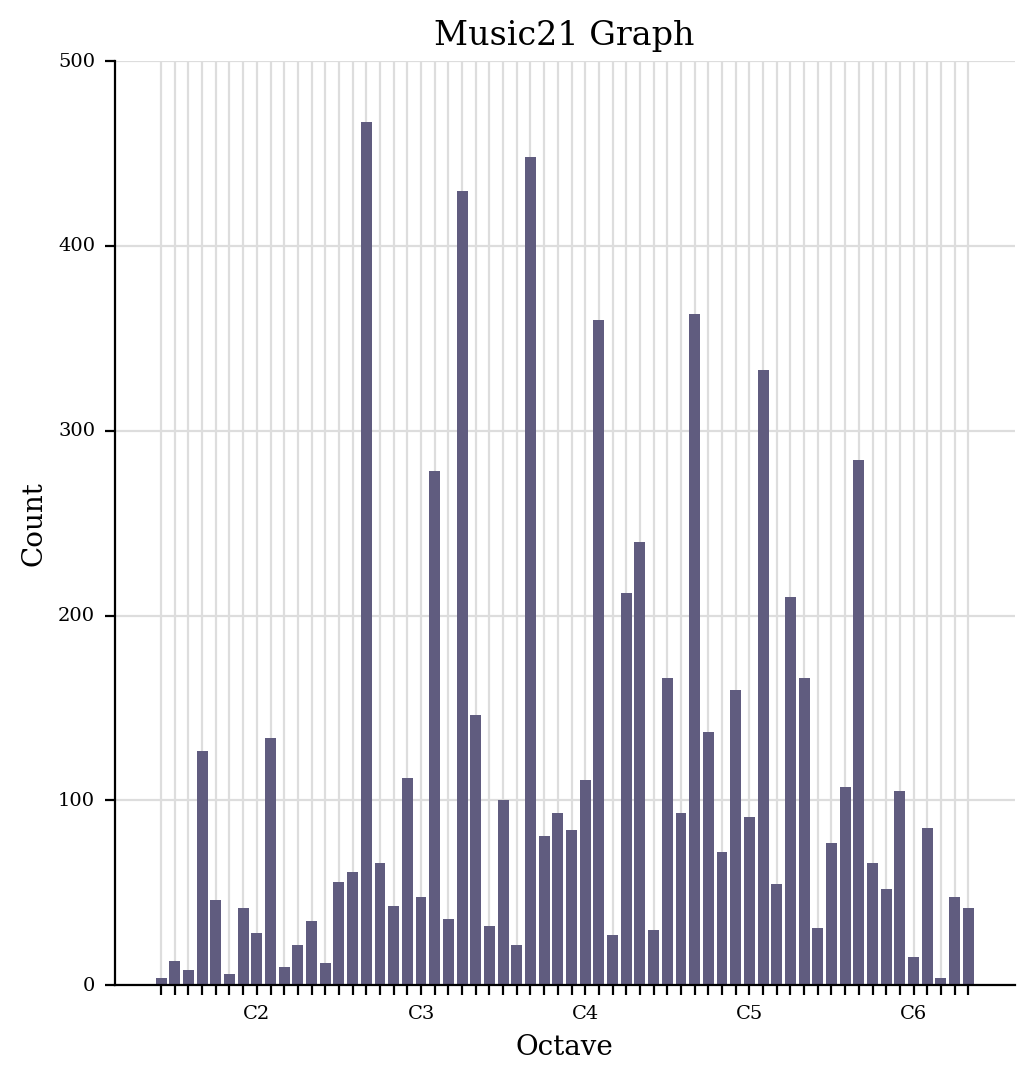
Below is an example of the pitch frequency in the vertical axis and the two coordinates along the horizontal directions are pitch and note length.
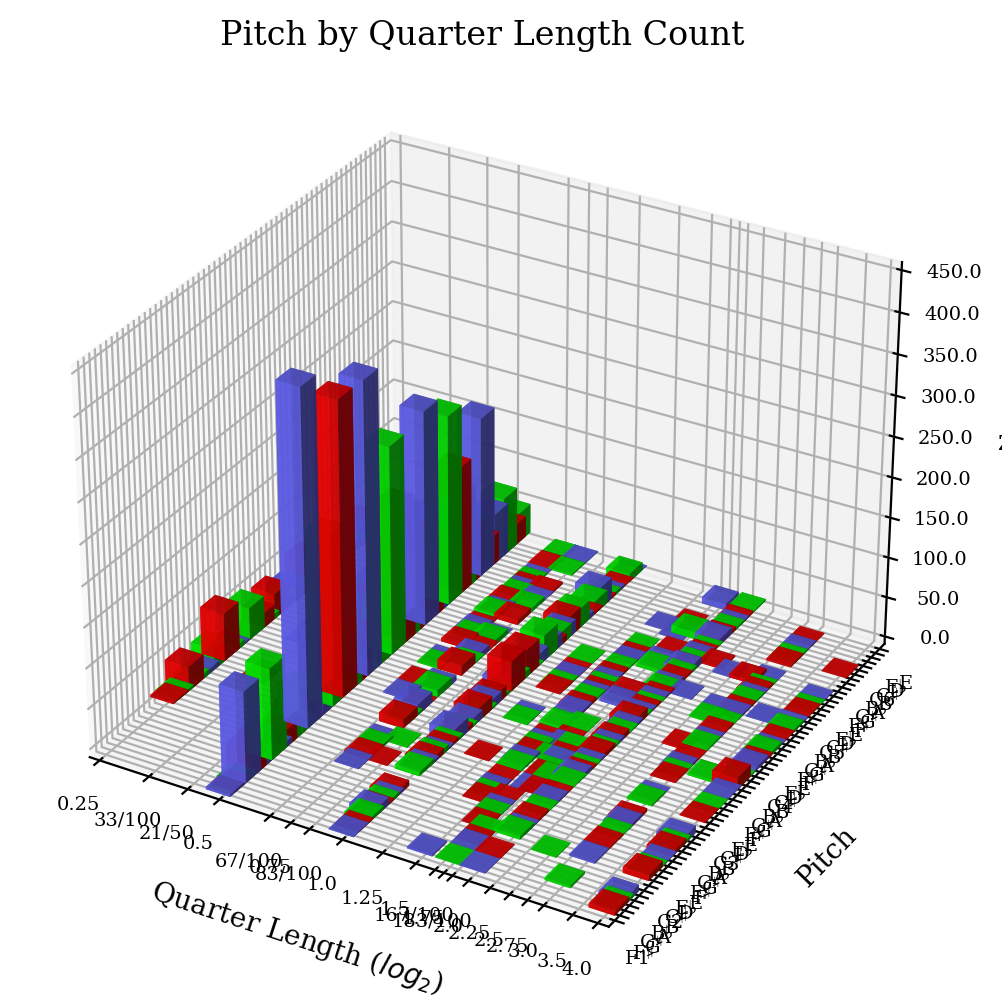
WAV File Visualization
Now we examine samples of WAV files for each composer in a multitude of ways. We obtain a random composition as a WAV file for each composer and visualize the data.
Visualizing the audio in time domain: Time on x-axis and Amplitude on y-axis. Here, in the following examples, the sampling rate is 22050 samples, i.e, in 1 second 22050 samples are taken. This means that the data is sampled every 0.046 milliseconds.
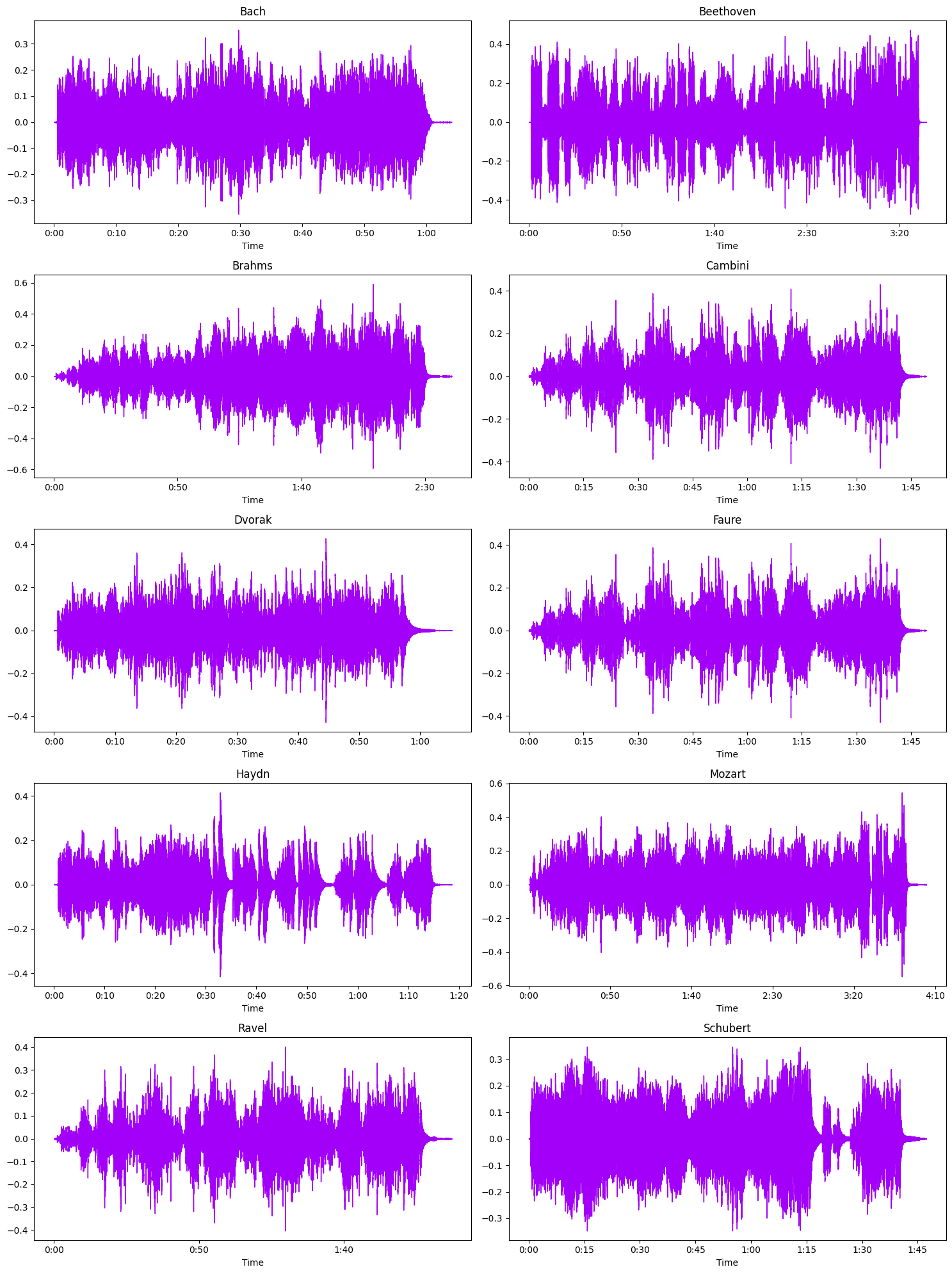
The zero crossing rate indicates the number of times that a signal crosses the horizontal axis.
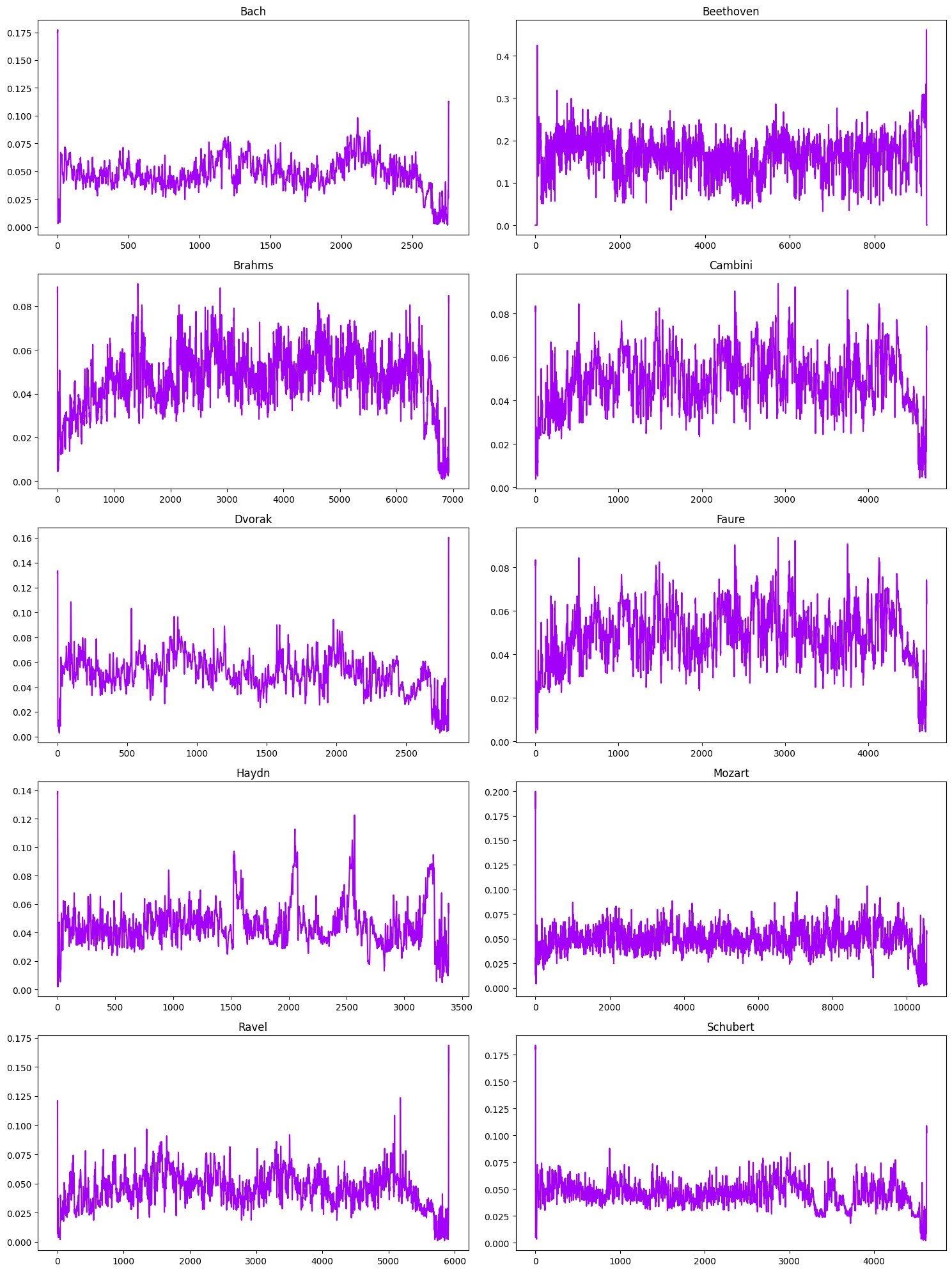
The STFT represents a signal in the time-frequency domain by computing discrete Fourier transforms (DFT) over short overlapping windows. Frequency is on the x-axis and Intensity is on the y-axis
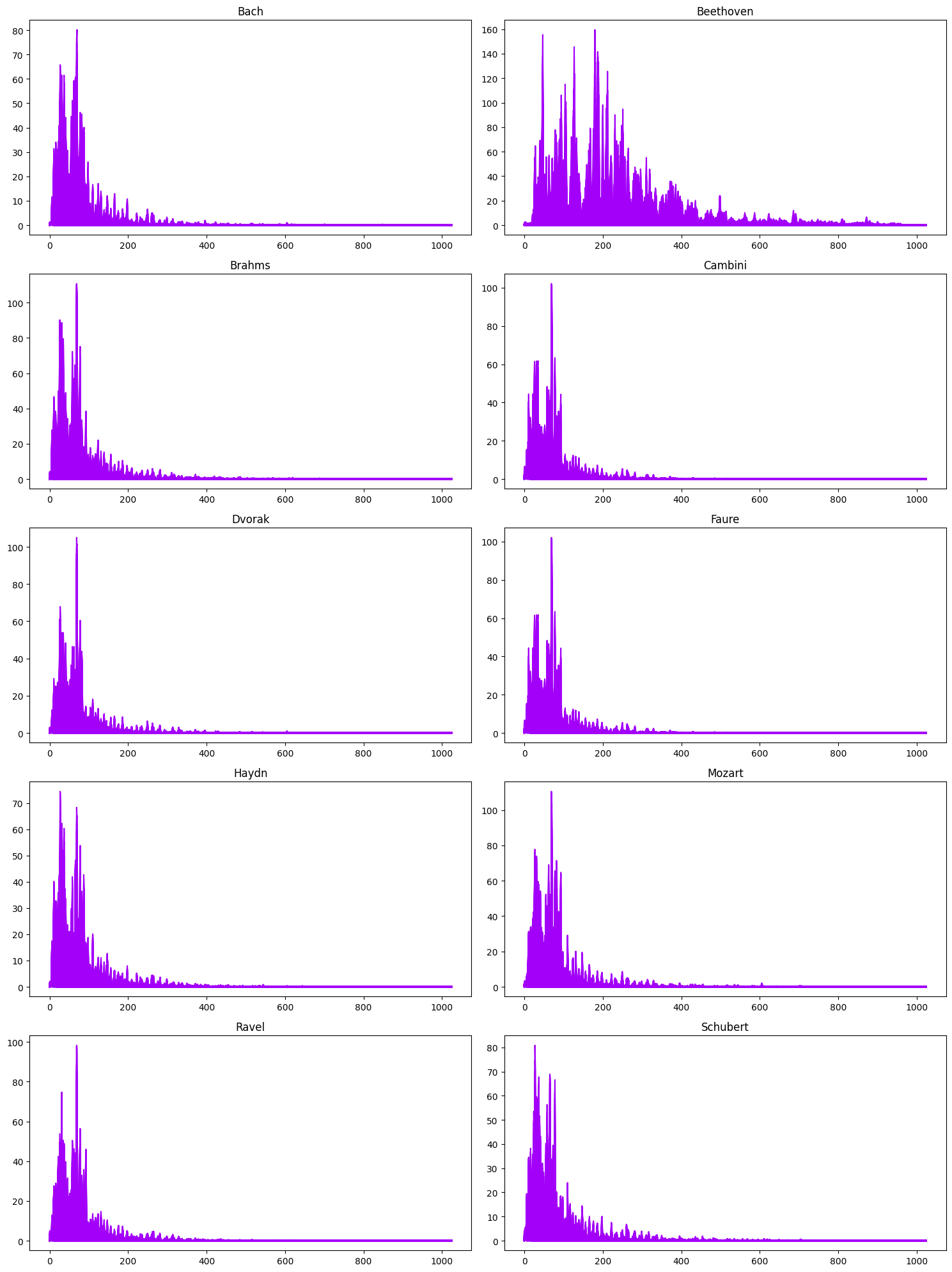
A Spectogram represents the intensity of a signal over time at various frequencies. Time is on the x-axis and Intensity of Frequency is on the y-axis
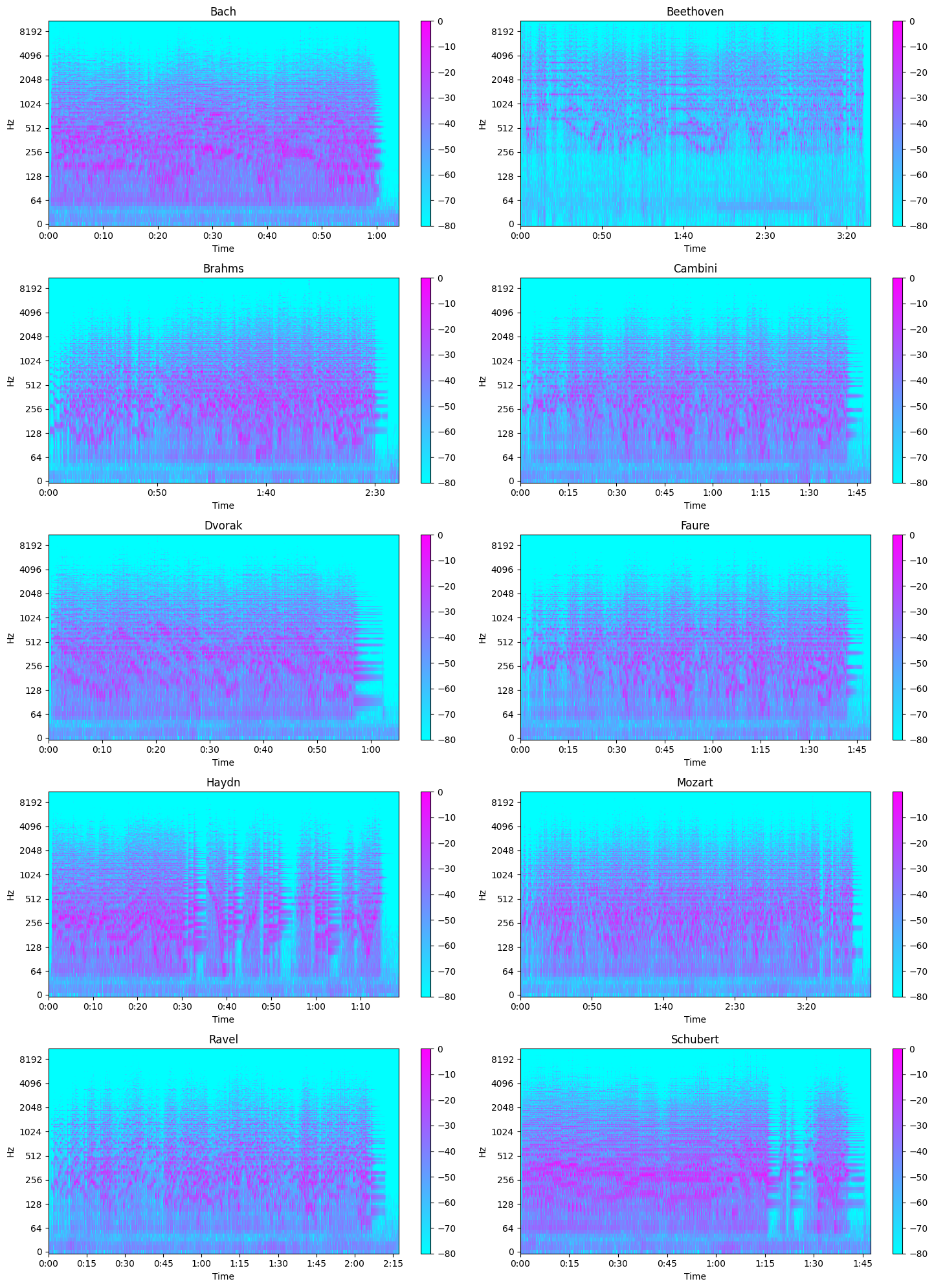
The Mel Scale is a logarithmic transformation of a signal’s frequency. The core idea of this transformation is that sounds of equal distance on the Mel Scale are perceived to be of equal distance to humans. Hence, it mimics our own perception of sound. The transformation of frequency to mel scale is: m = 1127xln(1 + f/700) Mel Spectrograms are spectrograms that visualize sounds on the Mel scale.
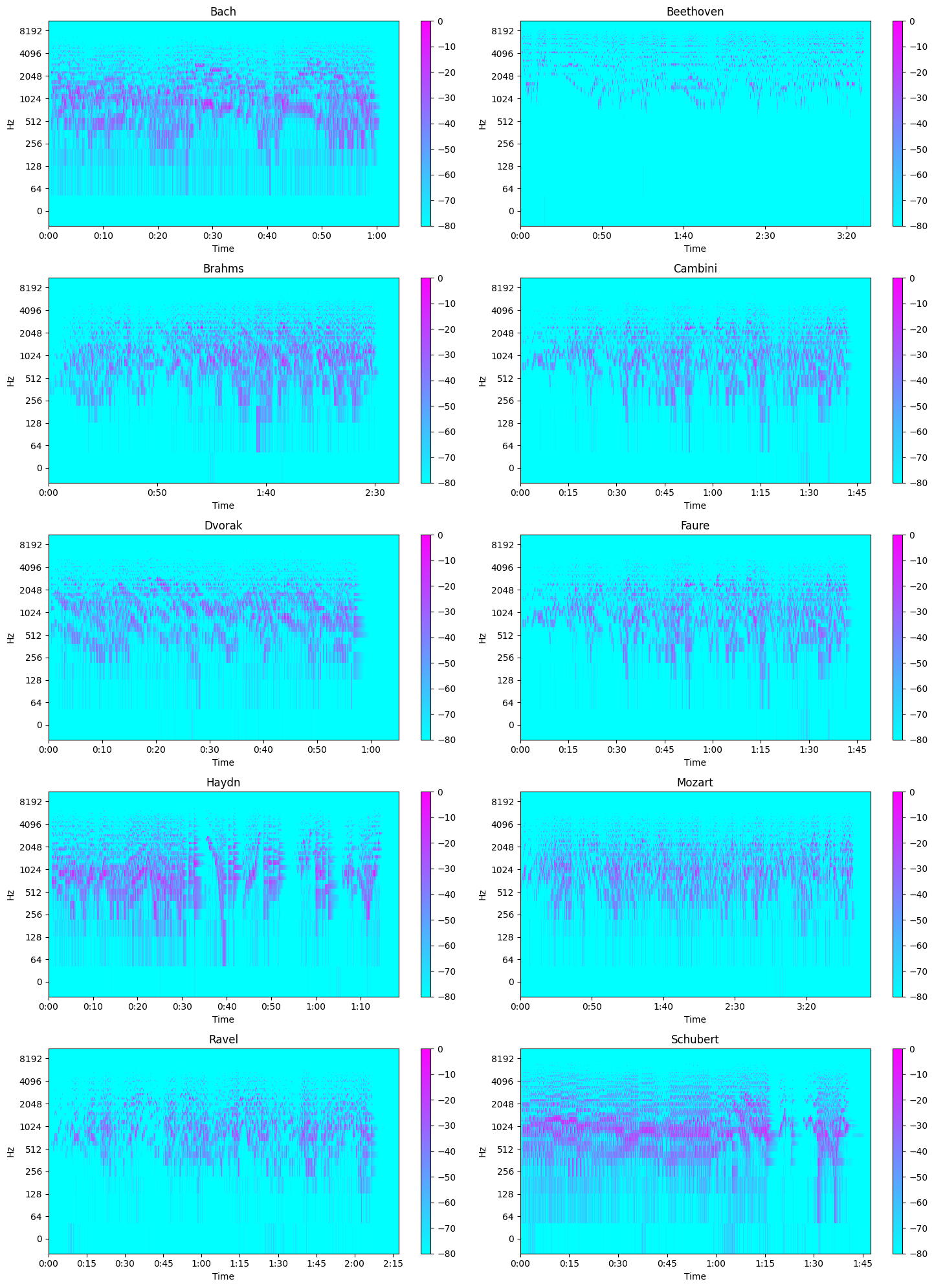
Chromagram sequence of chroma features each expressing how the representation’s pitch content within the time window is spread over the twelve chroma bands/pitches.
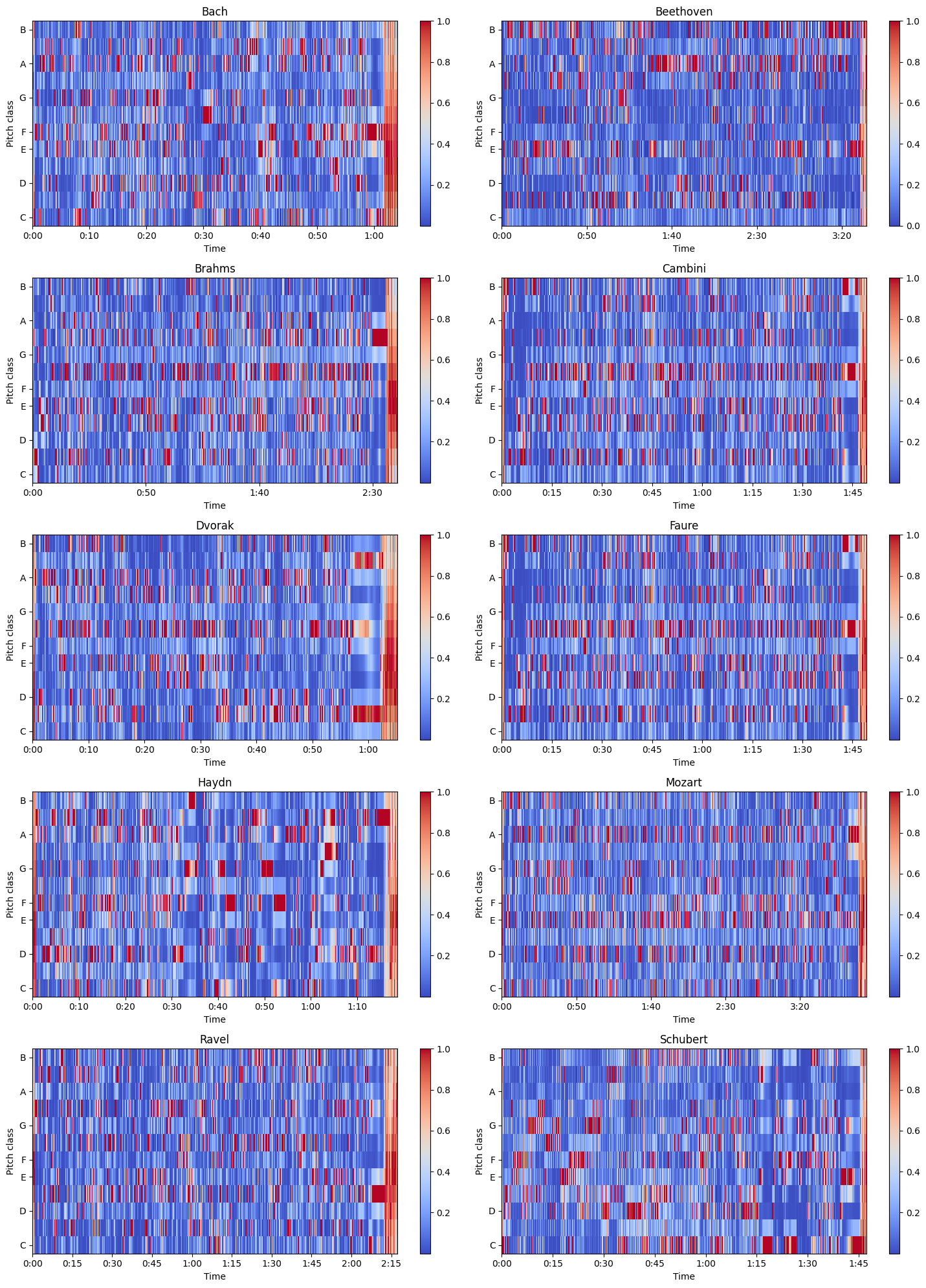
Data Preprocessing
MusicNet:
MIDI Files
For the MIDI files, we aimed to create an algorithm to parse through MIDI files and convert into row vectors to be stored into a data matrix X. We utilize the MIDI parsing software from python-midi to parse through the MIDI files and obtain tensors of float values that corresond to the instrument, the pitch of the note, and the loudness of the note. Each MIDI file generated a (Ix Px A) tensor stored as a 3-D numpy array where I is the number of instruments, P is the total number of pitches, which range from (1-128), and the total number of quarter notes in the piece A. I is held as a constant of 16. For any instrument not played, it simply stores a matrix of zeroes. Additionally, the number of quarter notes in each piece is vastly different. Therefore, we require a way to process this data in a way that is homogenous in its dimensions.
We take the average values of each piece across the 3rd dimension (axis = 2) generating a 2-D array of size 16x128 where each entry is the average float value for that corresponding pitch and instrument across every note in the piece. From here, we flatten the 2-D array to generate a 1-D array of size 16*128 = 2048, where each block of values 128 entries long corresponds to an instrument. This flattening procedure respects the order of the instruments in a consistent manner across all MIDI files and is capable of storing instrument information for all MIDI files within the domain of the 16 instruments. The 16 instruments consist of the most common instruments in classical music including piano, violin, bass, cello, drums, voice, etc. Although the memory is costly, and the non-zero entries in each row vector are quite sparse, we determined that this procedure would be a viable method to maintain information in a manner that is feasible and reasonably efficient for our task.
In summary, we parse through each MIDI file and undergo a basic algorithm to generate row vectors of float values for each composition. We do this for each MIDI file and generate a data matrix X_{MIDI} that is a R^{330x2048} stored as a 2-D array of float values. This data matrix X_{MIDI} is what we will process through supervised models in the future and is the data we further explore with Principal Component Analysis detailed in the next section for MusicNet.
WAV Files
For WAV files, we obtain a 1-D array for each song consisting of amplitude float values. Each entry corresponds to a timestep in which the WAV file is sampled which is determined by the sampling rate specified when loading the data. We use the librosa audio analysis package in Python to load WAV files. After data is loaded, take intervals of the WAV data to act as a single data point. The sampling rate is defined as the average number of samples obtained in 1 second. It is used while converting the continuous data to a discrete data. For example, a 30 s song with a sampling rate of 2 would generate a 1-D float array of length 60. If we specify intervals of 3 s, then we would obtain 20 distinct data points each with 3 values (each for amplitude). A possible exploration with this data, because it is sequential, is to use models specifically tailored towards processing sequential data and learning relations between points in a sequence, such as transformers. However, we currently only perform this minimal processing for MusicNet in order to visualize and understand the data, and obtain baseline performances in supervised models to compare to performances with other processed data.
Images
Lastly, we discussed and showed a thorough treatment of visualization in the EDA section above. As done in [2.], we plan on exploring using images as input data to perform the classficiation task, possibly in addition to other data, creating a multi-modal classification model. A likely supervised model we will explore for inputting images are Convolutional Neural Networks (CNNs).
GTZAN:
Extracted Features:
The GTZAN dataset also provides a list of extracted features. There are total of 58 features, which drastically reduces the dimensionality of our input data.
Frequency Space representation using Discrete FFT:
On top of doing supervised learning with the extracted features that the dataset provides, we also directly train on the wav files. To inrease the number of training examples and reduce the dimensionality of the data set, we use 2 second clips instead of the full 30 second clips. To translate the dataset to useful information, we must extract the frequency information. This is because musical notes are made of different frequencies. For example, the fundamental frequency of the middle C is 256 Hz. Translating audio segments into frequencies will allow the model to understand the input much better. To do this, we use a technique called the Fourier Transform. The fourier transform is a way to translate complex value functions into its frequency representations. In our application, we use the finite, discrete version of fourier transform that works on finite vectors rather than functions. In particular, we use a technique called Fast Fourier Transform (FFT) to speed up computation. For every m samples of the 2 second clip, we extract the frequency information from that vector in R^m. We create datasets using m values of 256 and 512. In the end, we end up with a training input of NxTxF, where the first dimension (N) indicates which training sample (2 second clip we are using), the second dimension (T) indicates which of the 256 sample time stamp in the 2 second clip we are in, and the third dimension (F) representing which frequencies (musical notes) are present during that clip.
Dimensionality Reduction - PCA
MusicNet: We perform dimensionality reduction using Principal Components Analysis (PCA) on the pre-processed MIDI data. We hope to be able reduce the number of features especially due to the large amount of sparisity in each row vector. Because most of the songs only have 1-2 instruments, which means that for most songs there would be at most 256 non-zero entries, we expect to be able to significanlty reduce the number of features while maitining separability in our data.
We can see that there is no separation between Beethoven and Bach classes in the first two principal directions.
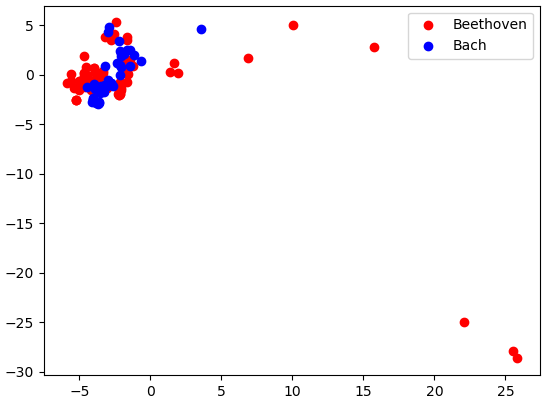
However, very clear separation between Cambini and Bach exists in our data in the first two principal directions.
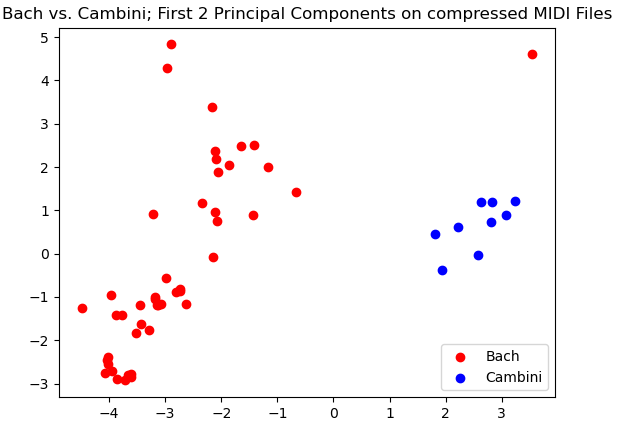
Here we see promising separation between Mozart and Cambini. Although they may not be linearly separable in this case, there is a clear distinction between the clusters of data in our data for their first two principal components.
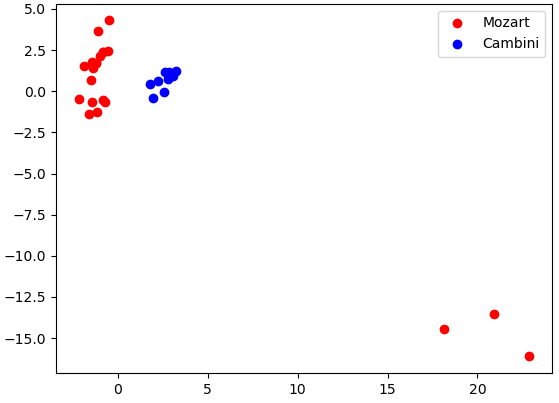
Here again we see a lack of separability for the first two principal components of Bach and Schubert. A strong contrast between Bach vs. Cambini, which did show a high amount of separability. This demonstrates that when performing this classification task on this processed MIDI data, it is likely that the model will struggle to perform well in delineating Bach and Schubert more than it does delineating Bach and Cambini.
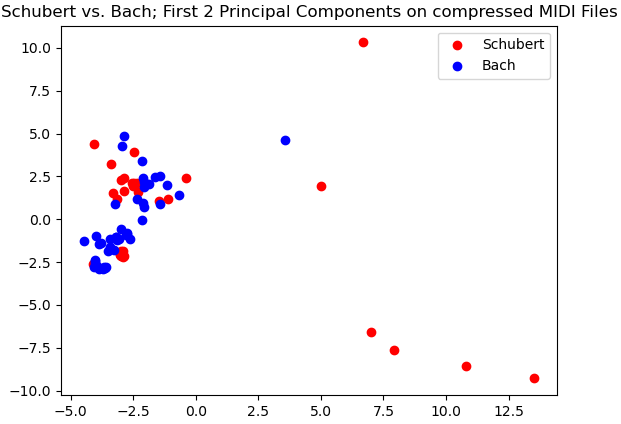
GTZAN: After we get our dataset represented by a NxTxF matrix, we perform Principal Component Analysis (PCA) on the dataset. The reason we do this is to reduce the dimensionality of the dataset while mostly maintaining the information we have. This will allow us to train smaller and better models. To do this, we flatten the tensor into a (NT)xF matrix. We then perform PCA to get a (NT)xF’ model. We then reshape it back to a NxTxF’ tensor. We will be testing models utilizing different values of F’.
Classification
MusicNet - Choice of Model and Algorithms:
Chosen Model(s): We opted to only perform classification on the GTZAN dataset. MusicNet requires more thorough processing and either trimming the dataset down to obtain a better distribution of data by class or retrieving data manually. This is discussed more in the Discussion section.
GTZAN - Choice of Model and Algorithms:
Chosen Model(s): We experimented with a feedforward neural network. As the input data consisted only of extracted features that were not spatially or temporally related, a CNN, RNN, transformer, or other kind of model was not needed. We chose the neural network as we believed we had sufficient training samples and that this function may be sufficiently complex for a neural network to approximate. We will explore this further by implementing other non-NN machine learning models in the future.
To begin, the 3-second variant was experimented with. We made a 10% split from our training dataset to create a validation set to detect when overfitting was occurring. Early stopping was implemented such that training would halt as soon as 3 epochs had the validation loss not decrease. We employed a softmax activation function for our final layer (as this is a multiclass single-label classification problem) and the categorical cross-entropy loss. For hidden layers, we used ReLU. For a network this shallow, no vanishing gradients were observed, making the use of a ReLU variant (such as LeakyReLU) unnecessary. The Adam optimizer was used with a learning rate of 10^-3.
The iteration over model architectures began with a single hidden layer of 32 neurons. From there, the number of neurons was increased, and as signs of overfitting were noticed, dropout regularization was added in. Not only did this prevent overfitting, but it also improved model performance compared to less parameter-dense networks, likely a consequence of breaking co-adaptations. Ultimately, performance peaked with a network consisting of 2 hidden layers, each with a 0.5 dropout and 512 neurons each.
However, it is important to note that performance did not climb significantly from a single-hidden-layer network with just 128 neurons and dropout. After this, additional improvements to model capacity provided diminishing returns for the increased needs for computing.
With similar experimentation, it was found (along with optimizer parameters) that a batch size of 32 resulted in the best performance, reaching 90+% accuracy on the well-balanced test set. When dealing with the 30-second variant, the number of training samples drastically reduced, making overfitting a concern. While we ultimately ended up using virtually the same setup (only a smaller batch size, this time 16), we had to make changes to the size and number of layers.
It was found that the ceiling for performance was a model that had two 64-neuron hidden layers with a dropout of 0.5 each. Anything more complex, and the model would simply start to overfit (triggering early stopping) before it could properly converge on a good solution.
In any case, the smaller dataset and smaller model resulted in severely degraded test set performance, with the neural network only achieving an accuracy of just over 70%.
Results and Discussion
Quantitative metrics: 3-second samples
F1 Scores, confusion matrix, etc.
- Confusion Matrix:
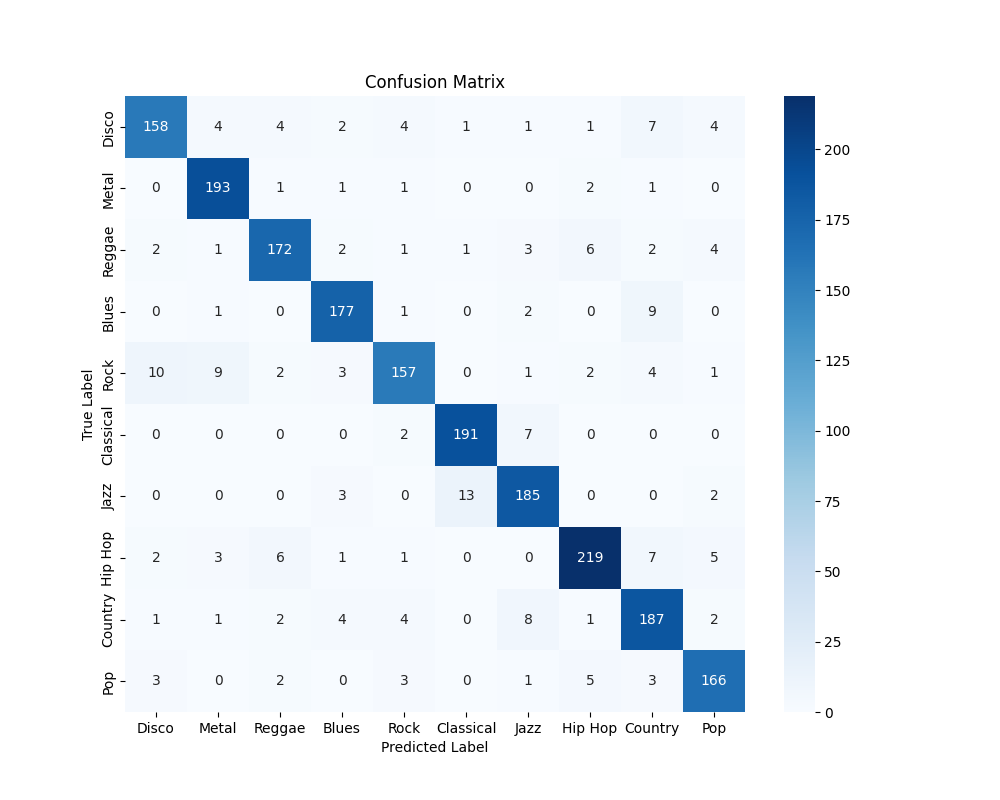
- Loss:
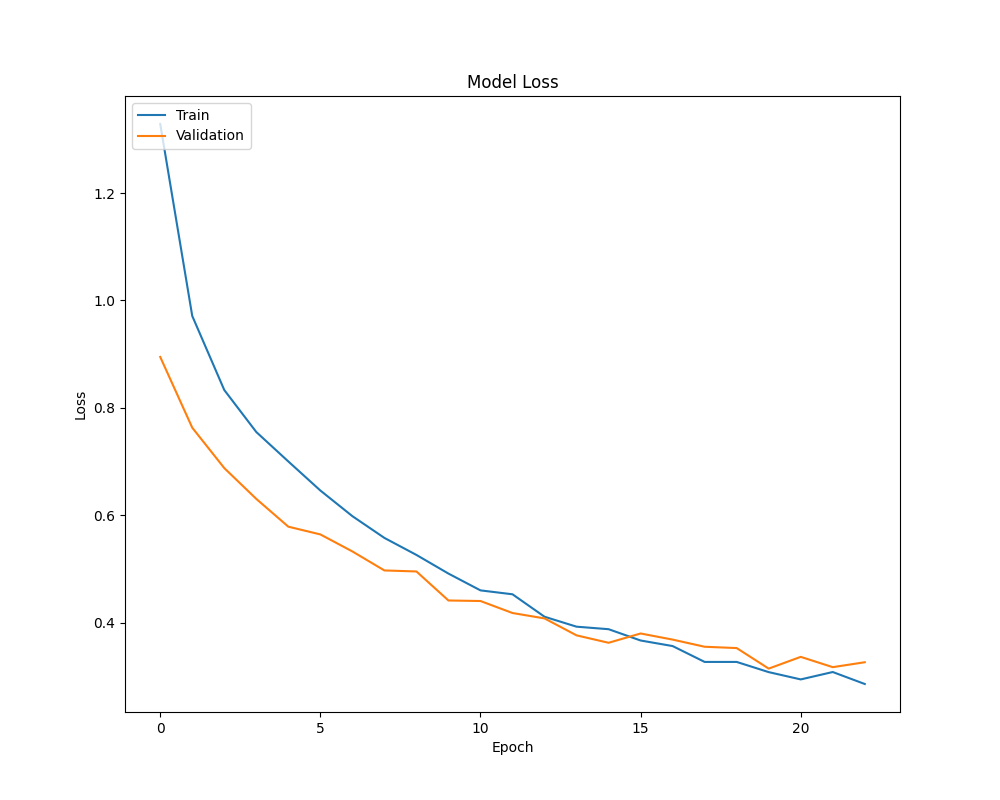
Quantitative metrics: 30-second samples
F1 Scores, confusion matrix, etc.
- Confusion Matrix:
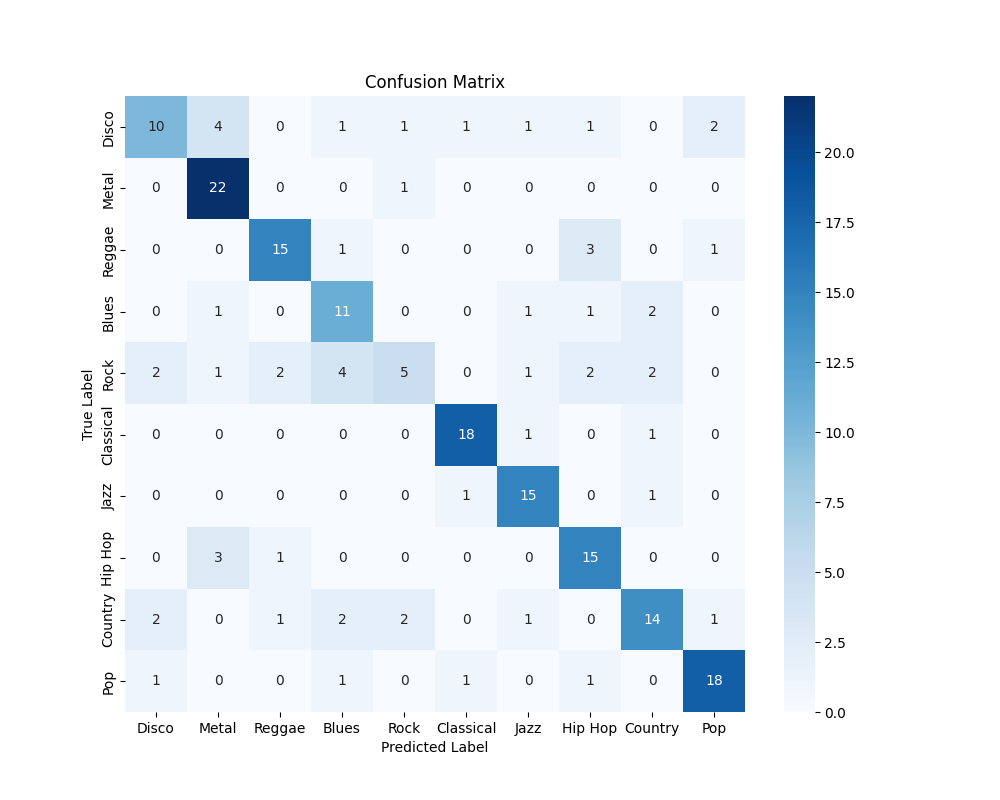
- Loss:
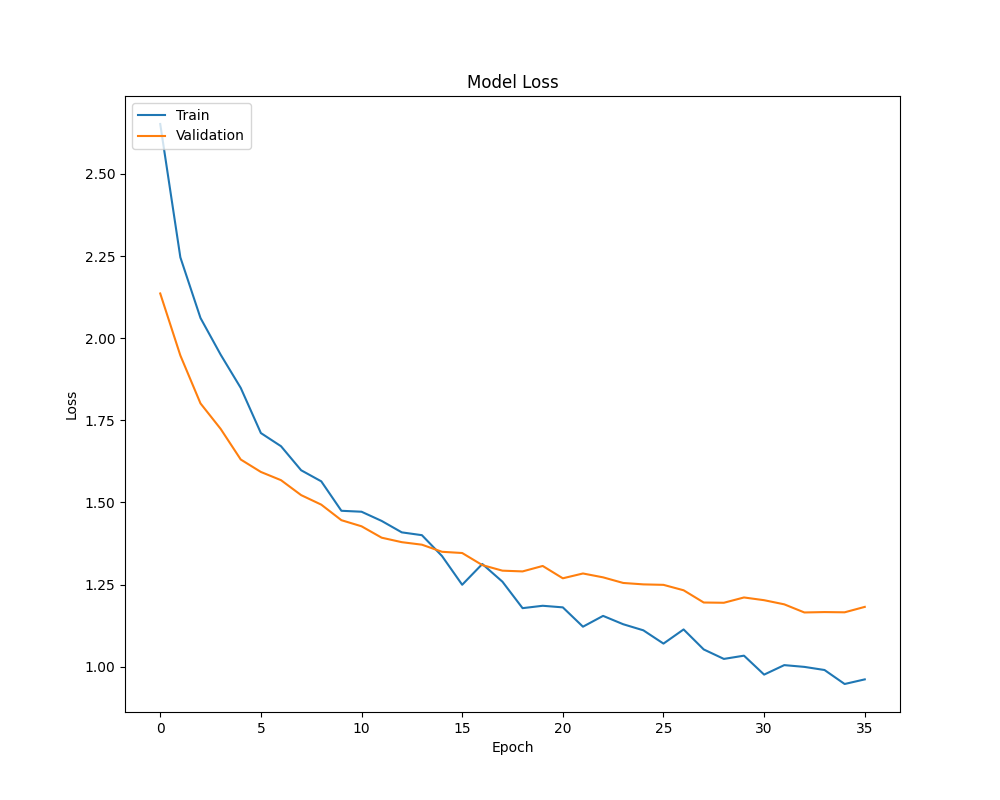
Discussion
MusicNet: After performing much of the data visualization on the data that we collected from the Kaggle dataset, we noticed that the data was not distributed well. We found that the reason for this distribution is that we need to get more data if we want to reliably do classification on all the composers in the dataset. For instance, we noticed that certain composers like Bach had over 100 songs that we were able to use as data points whereas other composers like Haydn had less than 5 songs within the given dataset, which likely caused this disparity in the results. Because of this, we plan on adding more songs from the different composers to account for this disparity our results. We also found that the PCA results of the MIDI data are promising and show separability in the data. In addition to using more sophisticated models, we plan on using a multi-modal classification model that processes MIDI numerical data and also possibly including images of MIDI roles and/or mel-spectrogram graphs. This entails processing not only the raw numerical MIDI data but also considering supplementary information in the form of images, such as MIDI rolls or mel-spectrogram graphs.
GTZAN: One reoccurring error involved the misclassification of rock music samples. Our model had a tendency to mistakenly label rock compositions as either disco or metal, where this misclassification indicates a potential overlap in the feature space or characteristic patterns shared between rock, disco, and metal genres. The challenge lies in distinguishing subtle distinctions that define each genre, such as rhythm patterns, instrumentations, or tonal characteristics, which might be shared or confused by our model. Addressing this misclassification will require a more nuanced feature representation and a deeper understanding of the distinctive elements that differentiate rock from disco and metal.
Another notable misclassification involved a significant number of jazz music samples being incorrectly labeled as classical. This misclassification hints at shared features or structural elements between jazz and classical music that pose challenges for our model. Improving the model’s ability to discern the subtle nuances that distinguish jazz from classical music will be crucial for rectifying this specific misclassification.
Overall: Based on both the MusicNet and GTZAN datasets, we noticed that the uneven distribution of data among the composers in MusicNet has suggested the recognition of potential biases, leading us to plan to address this disparity by increasing the dataset with more compositions from various composers. Additionally, we plan to incorporate numerical MIDI data as well as images like mel-spectrogram graphs. For GTZAN, we propose solutions that involve refining our understanding of distinctive elements when discerning musical nuances, especially in rock and jazz. Based on these results, we can improve our model accuracy and robustness in completing music classification tasks.
Next Steps
MusicNet: We will gather data manually to improve the overall distribution of data by classes or trim the dataset down to only include classes with a minimum number of data points. We will use the processed MIDI data, WAV data, and potentially images to implement two different supervised models - Neural Networks and Decision Trees. If time permits, we will revisit/re-explore data visualization use t-SNE as a nonlinear dimensionality reduction method for the processed MIDI files.
GTZAN: We plan to incorporate a multi-modal approach to classification using the existing Feedforward Neural Network approach with WAV data as input as well as Convolutional Neural Networks with image data such as Mel Spectrogram PNG files. If time permits, we will explore utilizing Transformers on the WAV data due to the sequential nature of music data and the feasibility of being able to train transformer models to learn context within samples of music using the attention mechanisms.
Contribution Table
| Contributor Name | Contribution Type |
|---|---|
| Austin Barton | MusicNet Data Pre-Processing, MusicNet PCA, MIDI Parsing, Data Visualization, GitHub Pages |
| Aditya Radhakrishnan | Model Design & Implementation, Development/Iteration, Validation, Testing, Results Generation & Visualization, and Early Dataset Balancing Exploration |
| Isabelle Murray | GanttChart, Model Implementation/Development, Testing, Results Generation & Visualization |
| Karpagam Karthikeyan | GanttChart, MusicNet Data Pre-Processing, Github Pages, Data Visualization, MIDI Parsing |
| Niki (Keyang) Lu | GTZAN Data Preprocessing & Visualization |
Gantt Chart
Link to Gantt Chart: Gantt Chart
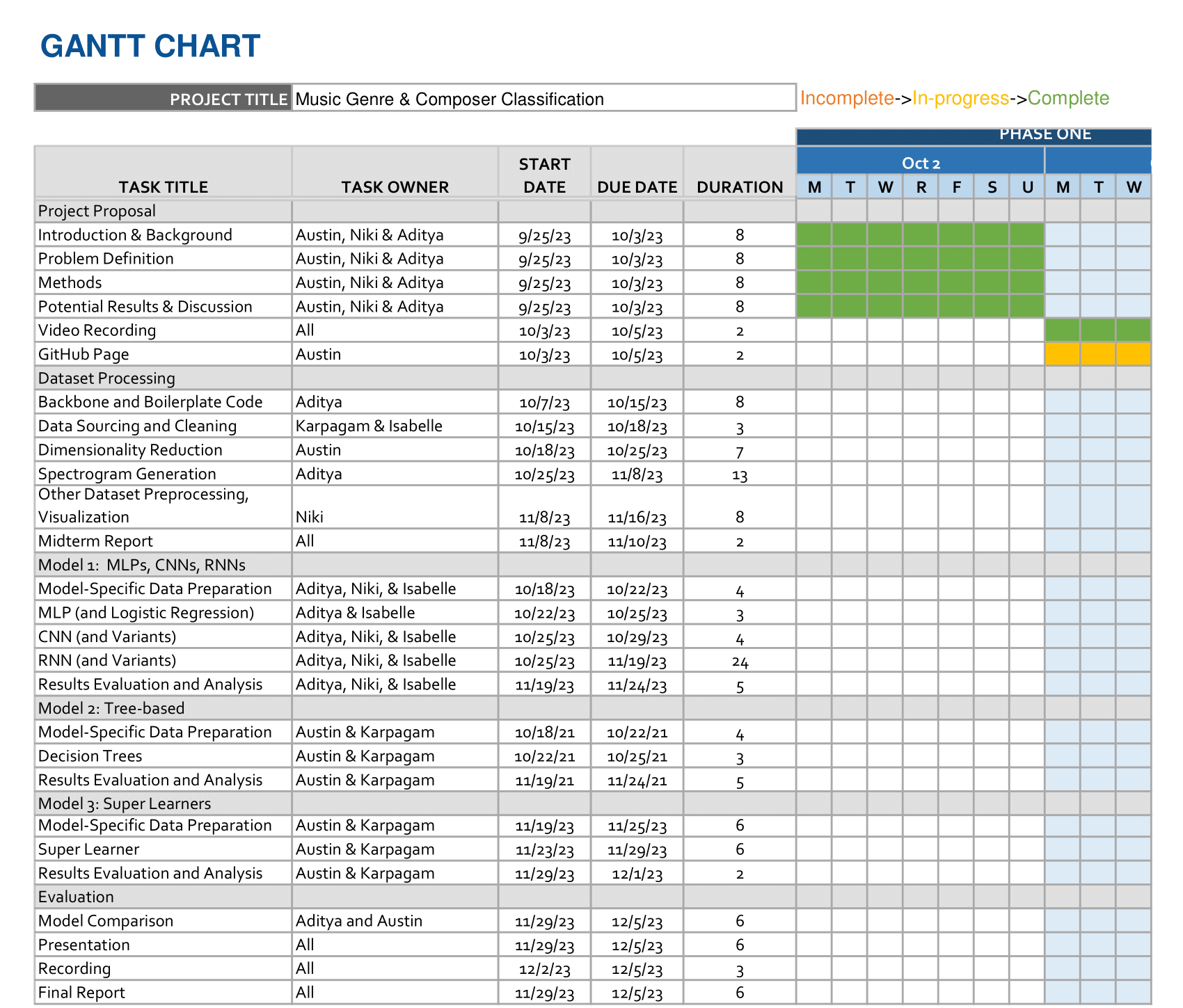

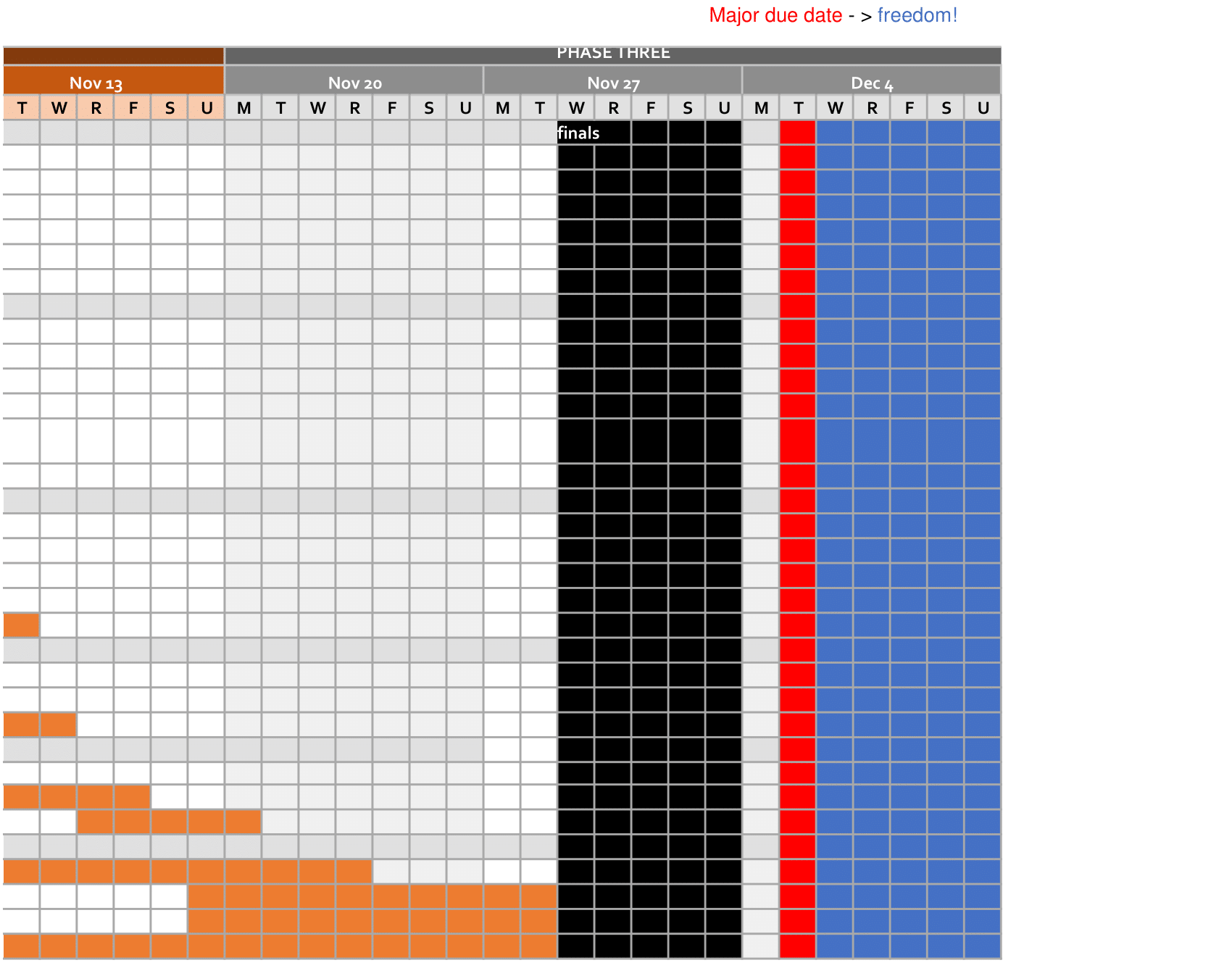
References
[1.] Pun, A., &; Nazirkhanova, K. (2021). Music Genre Classification with Mel Spectrograms and CNN
[2.] Jain, S., Smit, A., &; Yngesjo, T. (2019). Analysis and Classification of Symbolic Western Classical Music by Composer.
[3.] Pál, T., & Várkonyi, D.T. (2020). Comparison of Dimensionality Reduction Techniques on Audio Signals. Conference on Theory and Practice of Information Technologies.
